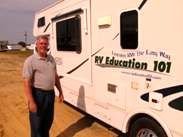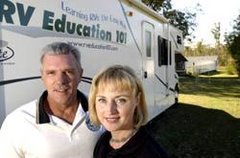Towing
Whenever you are determining the tow capacity of a vehicle make sure you know what the rear axle ratio is. It is quite possible to have the same type and size of vehicle with the same engine and the tow ratings vary by several thousand pounds. The axle ratio is a comparison of how many times the drive shaft rotates, versus the rear wheels. A 4.10:1 axle ratio means the drive shaft or pinion gear rotates 4.1 times for each rotation of the rear axle or ring gear. The higher the numeric value the better the vehicle will tow. Some people have a misperception that a vehicle with 4-WD will have a higher tow rating than an identical vehicle that is two-wheel drive. In reality the 2-WD vehicle will have the higher tow rating. The reason for this is the transfer case in the four-wheel drive vehicle adds additional weight to the vehicle, usually close to 500 pounds, which lowers the tow rating by that same amount. Keep in mind that any weight you add to the tow vehicle takes that same amount of weight away from the vehicles tow rating and Gross Combined Weight Rating.
Deep Cycle Battery
RVs come equipped with deep cycle batteries for the coach's 12-volt DC electrical system. House or coach batteries need to be true deep cycle batteries that are designed to provide a steady amount of current over a long period of time. Starting batteries and marine batteries should not be used in this application. True deep cycle batteries have much thicker plates and are designed to be deeply discharged and recharged over and over again. Many RVs use a single deep cycle battery. Deep cycle batteries are rated in amp hours. How many amps the battery can deliver for how many hours before the battery is discharged. If you enjoy dry camping, without utility hook-ups, you depend on your deep cycle battery(s) to take care of your 12-volt needs. You can purchase a deep cycle battery with a higher amp hour capacity that will last longer. The higher the amp hour capacity is the larger and heavier the battery is. If you have room for a larger battery and enjoy dry camping you may want to upgrade your deep cycle battery to one with a higher amp hour rating. If your RV is equipped with a marine RV battery you may want to upgrade to a true deep cycle battery.
Water Pressure Regulator
Water pressure at campgrounds can be extremely high and can cause damage to your RV plumbing system. Always use a water pressure regulator when you hook-up to the campground water supply. Always connect the water pressure regulator directly to the campground water source. This way you regulate the water pressure where the water pressure originates. It's also a good idea to turn the water supply off if you're going to be away from the campground for extended periods of time.
Water Filters
You never know the condition or quality of potable water at different campgrounds. Always use a water filtration system to filter the drinking water in your RV, or take bottled water with you for drinking water.
Pet Safety
Take updated photos of your pets with you on camping trips. If they should get lost you can use the pictures to assist in finding them.
Safe Drinking Hose
Always use a non-toxic, white RV drinking hose for your potable water connection at the campground. Take a black or green garden hose along for all other purposes such as cleaning the RV or flushing out holding tanks. You will always be able to distinguish the difference by the color of the hose.
Pre-Trip Checks
Before leaving on a trip always check the license plate and inspection/emission sticker on the RV to make sure they are current or won't expire while you are away. Always make sure your RV insurance is current.
Simple Test for Water Leaks
A quick and easy way to test your RV plumbing system for leaks is to turn the 12-volt water pump on when there is water in the fresh water holding tank. Once it pressurizes the system and shuts off it should not come back on until you open a water faucet. If the pump does come on sporadically, even for short periods of time, water is leaking somewhere.
Trip Routing
Print a detailed map and routes of your entire trip from an Internet trip planning service. It is a free service and it is a great help in tracking distance, routes, and exits that you need to be watching for especially in congested areas. A GPS system helps too.
Proper Tire Inflation
Always check and add air to the tires when they are cold, before traveling. When tires get hot the air expands and you get a higher-pressure reading. If you let some air out they will be under inflated when they are cold.
Awning Protection
Awning tie downs help to protect your patio awning, but you should never leave your awning out during bad weather, or when you're not physically at the campsite. Wind and rain can damage your RV awning very quickly and it can be expensive to repair.
Wiper Blade Maintenance
Check the condition of your windshield wiper blades before you leave on a trip. This is one of those things we don't think about until the next time we need them. Periodically clean the wiper blades with windshield washer fluid.
Happy Camping!
Mark J. Polk
Copyright 2008 by Mark J. Polk owner of RV Education 101
RV Expert Mark Polk, seen on TV, is the producer & host of America's most highly regarded series of DVD's, videos, books, and e-books.







No comments:
Post a Comment